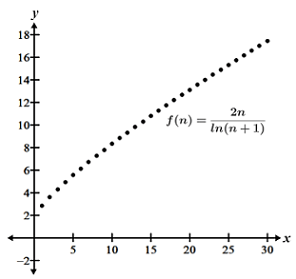Divergent sequence
Divergence is a concept used throughout calculus in the context of limits, sequences, and series. A divergent sequence is one in which the sequence does not approach a finite, specific value. Consider the sequence . We can determine whether the sequence diverges using limits. A sequence diverges if the limit of its nth term does not exist or is infinite. In other words:
If the limit is a real number, then the sequence converges. Referencing the above example, there are a few ways to determine whether the limit converges. By inspection, 2n increases at a significantly higher rate than ln(n + 1). Thus, the numerator of the expression gets increasingly larger relative to the denominator as n increases. For this reason, the sequence approaches infinity, and therefore diverges. The figure below shows the graph of the first 30 terms of the sequence. It confirms that as n increases, f(n) increases at a rate that indicates that it diverges.

Another way to determine that the sequence diverges is to use L'Hôpital's rule, described in a section below.
Techniques for determining divergence
A sequence diverges if the limit of its nth term does not exist or is infinite. Thus, the various methods used to find limits can also be applied when trying to determine whether a sequence diverges.
Comparing degrees of rational functions
If an is a rational expression of the form , where P(n) and Q(n) represent polynomial expressions, and Q(n) ≠ 0, first determine the degree of P(n) and Q(n). Then:
- If the degree of P is greater than the degree of Q, the sequence diverges since
- If the degree of Q is greater than the degree of P, the sequence converges since
- If the degree of Q is equal to the degree of P, the sequence converges, and
, where p and q are the coefficients of the terms (in P and Q respectively) with the highest degree
Example
Determine whether the following sequence diverges:
The degree of P = 3 and the degree of Q = 2. Since 3 > 2, , so the sequence diverges.
Using L'Hôpital's rule
In some cases, it is possible to use L'Hôpital's rule to determine whether a sequence diverges.
Example
Use L'Hôpital's rule to determine whether the following sequence diverges:
The limit of the sequence results in an indeterminate form ∞/∞, so apply L'Hôpital's rule:
The above limit still results in an indeterminate form ∞/∞, so apply L'Hôpital's rule again:
Since the limit of the sequence is ∞, the sequence diverges.
Divergence of geometric sequences
A geometric sequence is a sequence in which each successive term after the first is determined by multiplying the previous term by a fixed number referred to as the common ratio. The nth term of a geometric sequence is
where r is the common ratio, and can be determined as for n = 1, 2, 3,... n. A geometric sequence diverges if r ≤ -1 or r > 1. It converges if -1 < r ≤ 1. If r = 1, the geometric sequence will be a sequence of identical constants, and is therefore trivial.
Examples
Determine whether the following geometric sequences diverge:
i. To determine whether the geometric sequence diverges, first find r. We will do so using a1 and a2:
Since -1.5 ≤ -1, the sequence diverges.
ii. Find r using a1 and a2:
Since -1 < ½ ≤ 1, the sequence converges.
Bounded monotonic sequences
If a sequence is both bounded and monotonic, the sequence converges; otherwise it diverges. A bounded sequence is one in which there exist real numbers, A and B, for n = 1, 2, 3, ..., such that A ≤ an ≤ B. A sequence is monotonic if it is only increasing or decreasing. In other words, a1 ≤ a2 ≤ a3 ≤ ... ≤ an or a1 ≥ a2 ≥ a3 ≥ ... ≥ an.
Example
Determine whether the following sequence diverges:
A function is increasing if its first derivative is positive over the respective interval. The above sequence can be written in the form of a function as , and its derivative can be computed as follows:
Since f'(x) > 0 when x ≥ 1, where 1 is the lower bound of the sequence, f(x) is increasing, which indicates that is a monotonic sequence. If the upper bound of the sequence exists and is finite, the sequence converges. However, using L'Hôpital's to find the limit (the limit is of the form ∞/∞),
we see that the terms in the sequence approach infinity. Thus, the sequence does not have an upper bound, and therefore diverges.
